Physical Address
304 North Cardinal St.
Dorchester Center, MA 02124
On completion of this chapter, you should be able to:
Describe the early development of the embryo and its sonographic appearance at different gestational ages
Explain the clinical roles of first-trimester maternal serum biochemistry
Define the sonographic characteristics of the yolk sac, embryo, amnion and chorion, and gestational sac
Describe the sonographic measurements performed in the first trimester and the goals of first-trimester sonography
Transvaginal ultrasound evaluation of the first-trimester pregnancy is an important component of prenatal care. The ultrasound examination may diagnose conditions that require intervention, and even in “normal” intrauterine pregnancies (IUPs) the exam may provide patients and clinicians with information that influences clinical management. Information about multiple pregnancies, uterine anomalies, and pelvic masses that are readily visualized during the first trimester may be more difficult to obtain later.
Aspects of prenatal fetal screening and diagnosis are shifting from second trimester to first trimester. First-trimester aneuploidy screening protocols have higher detection rates than second-trimester tests. Genomic technology allows screening of cell-free fetal deoxyribonucleic acid (DNA) in early pregnancy. The current standard of care suggests offering aneuploidy screening during the first trimester to all obstetric patients and, where available, offering diagnostic genetic testing through chorionic villi sampling (CVS) between 11 and 13 weeks. Fetal anatomy has not been routinely assessed until the second trimester, but recent studies have demonstrated the possibility of detecting many structural anomalies earlier. In the morbidly obese gravida, assessment of fetal anatomy through transvaginal sonography in the late first trimester may be an improvement over second-trimester scanning.
Although the ability to image the first-trimester pregnancy with ultrasound may seem routine, the potential for false-positive and false-negative diagnoses for any given pathology is substantial. Extreme care should be taken when evaluating the first-trimester pregnancy sonographically.
It is especially important to have a clear understanding of terminology when discussing embryology. Embryologists state time in conceptual age , also known as embryologic age , with conception as the first day of pregnancy. Clinicians and sonographers use gestational age , also known as menstrual age , to date the pregnancy, with the first day of the last menstrual period (LMP) as the beginning of gestation. Thus the gestational age would add 2 weeks onto the conceptual age. For 12 days after conception, during the implantation process, the conceptus is called a zygote . From the time of implantation until the end of the 10th week menstrual age, the conceptus is called an embryo . After the first 10 weeks, the embryo is called a fetus .
Except when specifically noted, dates in this chapter reflect menstrual/gestational age rather than embryologic age. Menstrual age refers to the length of time calculated from the first day of the LMP, to the point at which the pregnancy is being assessed. During a 28-day menstrual cycle, a mature ovum is typically released at day 14. The ovum is swept into the distal fallopian tube via fimbriae; fertilization occurs within this region 1 to 2 days after ovulation. Meanwhile, the follicle that released the mature ovum hemorrhages and collapses to form the corpus luteum, which begins to secrete progesterone and estrogen ( Fig. 49.1 ).
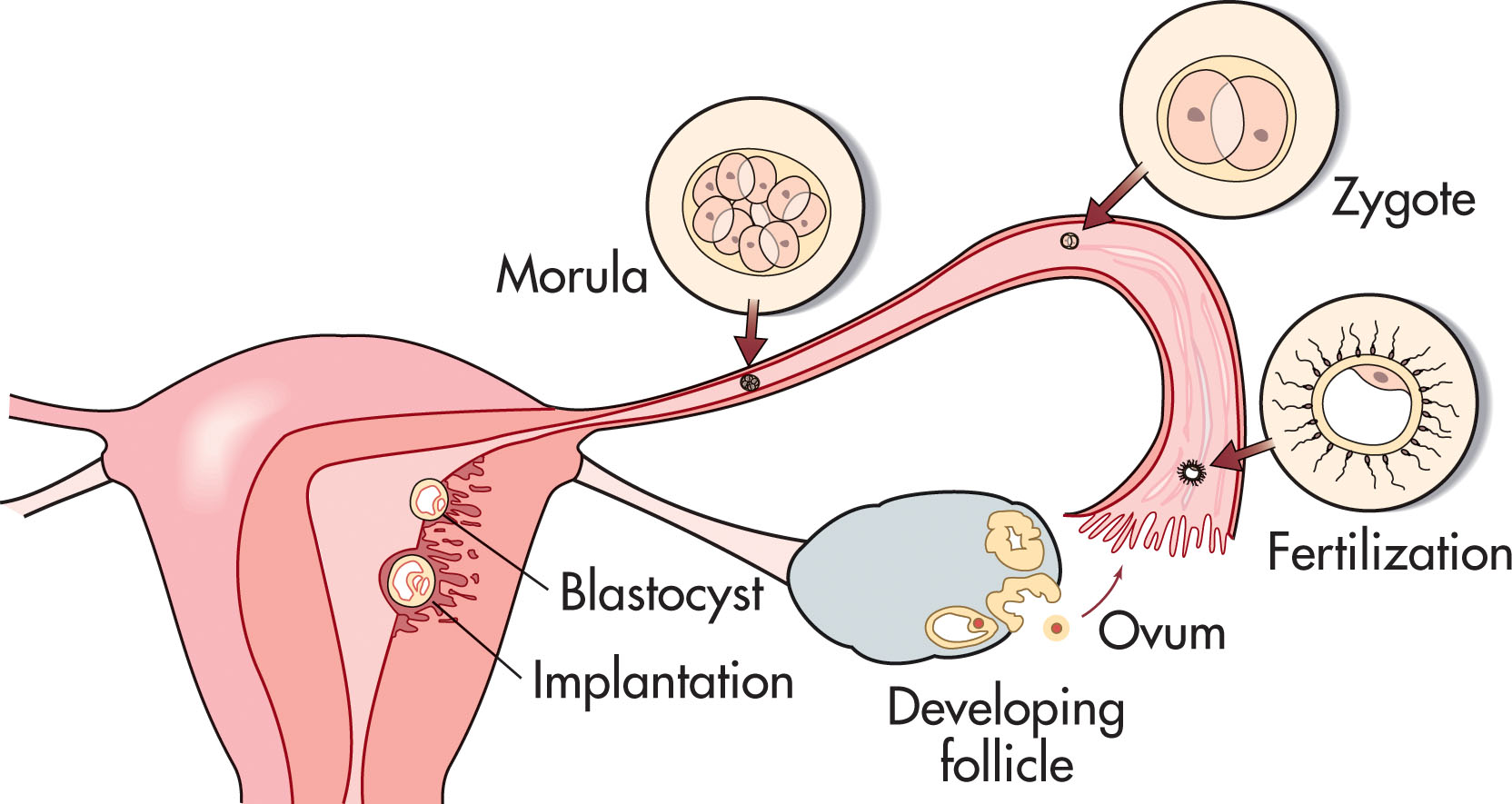
The fertilized conceptus that is now referred to as a zygote undergoes rapid cellular division to form the 16-cell morula. Further cell proliferation brings the morula to the blastocyst stage. The blastocyst contains trophoblastic cells and the “inner cell mass,” which forms the embryo. The trophoblastic cells begin to secrete human chorionic gonadotropin (hCG) that is absorbed within the tubes and stimulates maternal pregnancy responses.
The hCG causes the uterine endometrium to convert to decidua, a glycogen-rich mucosa that nourishes the early pregnancy. The blastocyst typically enters the uterus 4 to 5 days after fertilization. Implantation into the uterine decidua is completed within 12 days after fertilization. During implantation, proteolytic enzymes produced by the trophoblasts “eat into” decidual tissue, creating spaces for trophoblastic cell proliferation. Blood pools known as lacunae that form as maternal capillaries erode nourish the proliferating trophoblastic cells. A primitive blood exchange network between mother and conceptus is formed, and the lacunae and trophoblastic cells develop into a mature placental/maternal circulation complex that will sustain the pregnancy. By the end of the implantation process, the zygote has buried itself within one wall of the uterus. The implantation process sometimes results in light vaginal bleeding about the same time as the expected menstrual period.
When implantation is complete, the trophoblast has formed primary villi, which initially encircle the early gestational sac. Within the conceptus, the inner cell mass matures into the bilaminar embryonic disk, the future embryo, and the primary yolk sac ( Fig. 49.2 ). At approximately 23 days of menstrual age, the primary yolk sac is pinched off by the extraembryonic coelom, forming the secondary yolk sac . The secondary yolk sac is the yolk sac seen sonographically throughout the first trimester ( Fig. 49.3 ). The amniotic and chorionic cavities also develop and evolve during this period of gestation. Note the gestational sac should be visible by transvaginal ultrasound at 5 weeks, and the yolk sac may be visible from 5.5 weeks throughout the first trimester. The embryo is usually seen at 6 weeks, and the amnion is visualized at approximately 7 weeks.
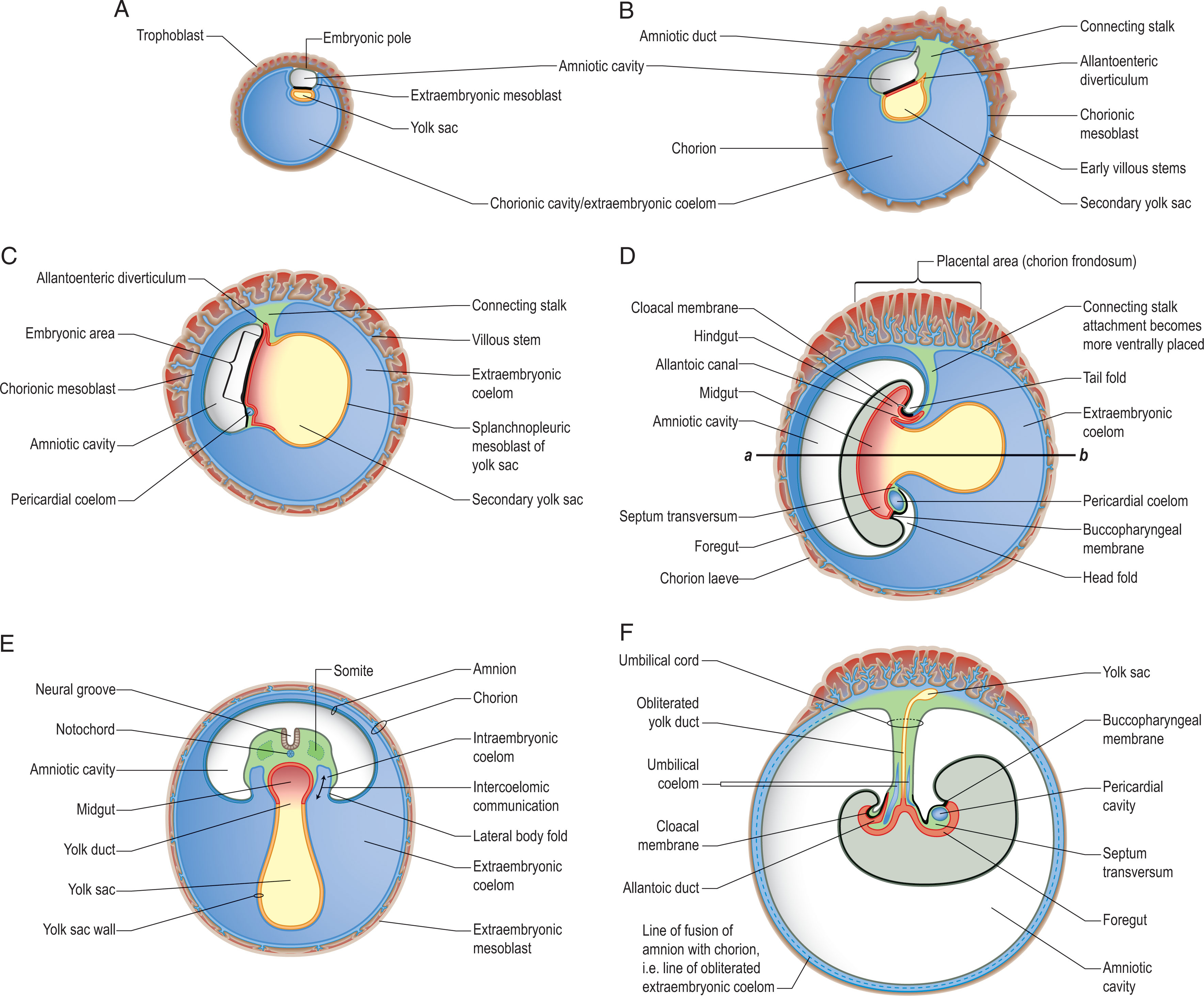
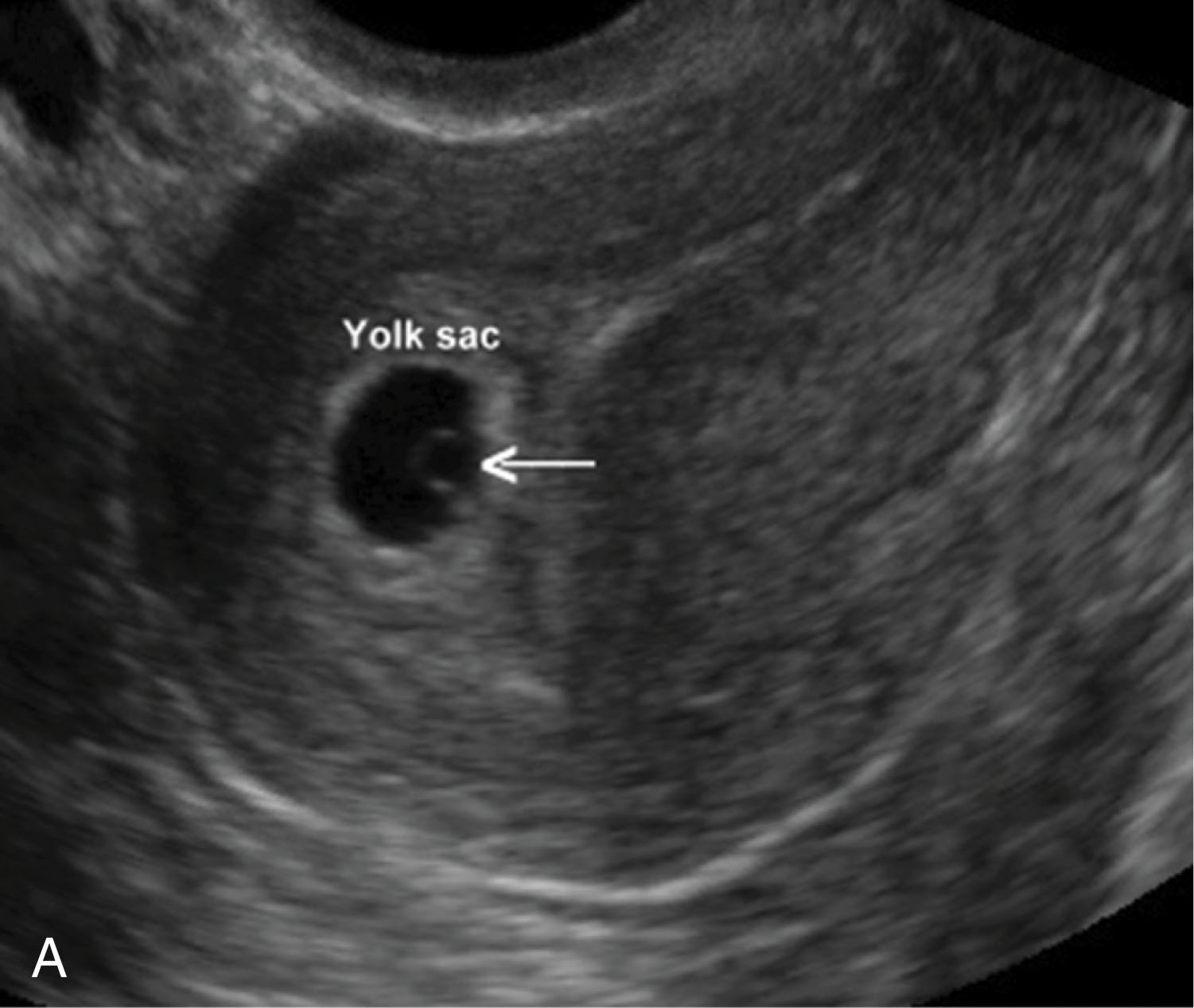
The embryonic phase occurs from the fourth to the ninth weeks ( Fig. 49.4 ). It is during this phase that all major internal and external structures begin to develop ( Table 49.1 ). The cardiovascular system undergoes rapid development, with the initial heartbeat occurring at approximately 5 to 6 weeks. The embryo’s appearance changes from a flat, disk-like configuration to a C-shaped structure, and it develops a human-like appearance. During this period of embryogenesis, the crown-rump length (CRL) develops rapidly, measuring 35 mm by the end of the 10th week.
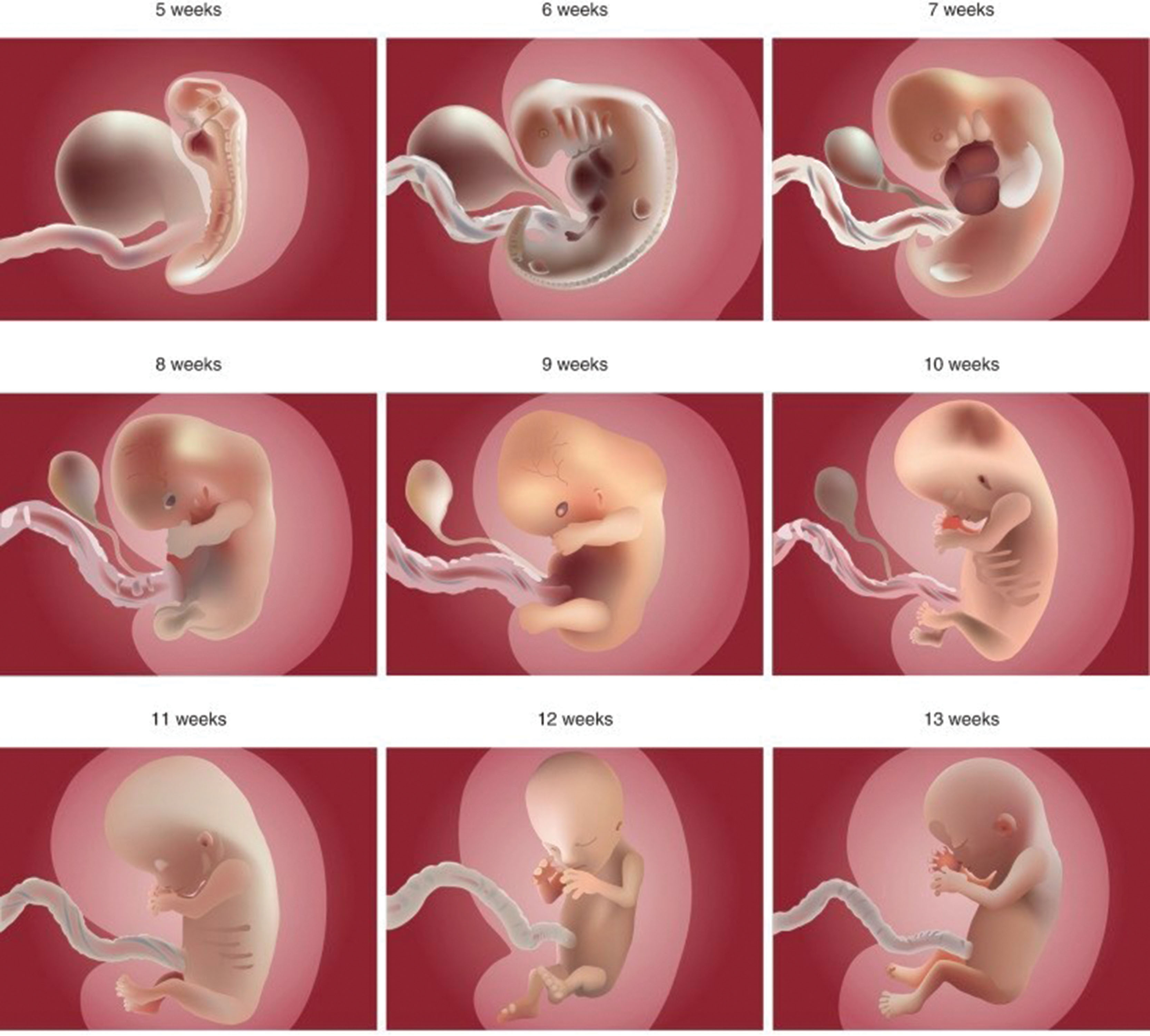
| Menstrual Age | CRL (mm) | Embryonic Observations |
|---|---|---|
| Week 5 | Prominent neural folds and neural groove are recognizable. | |
| Day 36 | Heart begins to beat. | |
| Week 6 | Anterior and posterior neuropores close and neural tube forms. | |
| Day 41 | Upper and lower limb buds are present. | |
| Day 42 | 4.0 | |
| Day 46 | Paddle-shaped hand plates are present; lens pits and optic cups have formed. | |
| Day 48 | Cerebral vesicles are distinct. | |
| Day 50 | Oral and nasal cavities are confluent. | |
| Day 52 | Upper lip is formed. | |
| Day 54 | Digital rays are distinct. | |
| Day 56 | 16.0 | |
| Week 9 | Cardiac ventricular septum is closed; truncus arteriosus divides into aorta and pulmonary trunk; kidney collecting tubules develop. | |
| Day 58 | Eyelids develop. | |
| Day 64 | Upper limbs bend at elbows; fingers are distinct. | |
| Week 10 | Glomeruli form in metanephros. | |
| Day 73 | Genitalia show some female characteristics but are still easily confused with male genitalia. | |
| Day 80 | Face has human appearance. | |
| Day 82 | Genitalia have male and female characteristics but still are not fully formed. | |
| Day 84 | 55.0 | |
| Month 7 | Ossification is complete throughout vertebral column. | |
| Month 8 | Ossification centers appear in distal femoral epiphysis. |
The last 3 weeks of the first trimester (weeks 10 to 12) constitute the beginning of the fetal period. During the fetal period, growth of the organs and structures formed during the embryonic period continues. At this stage, the fetal head is disproportionately larger than the rest of the fetus, constituting one half of the CRL ( Fig. 49.5 ). As the fetus grows, body growth accelerates, and this proportionality becomes less pronounced. Fetal anatomy is fully developed in the late first trimester, and the goal of sonography at this stage includes anomaly detection.
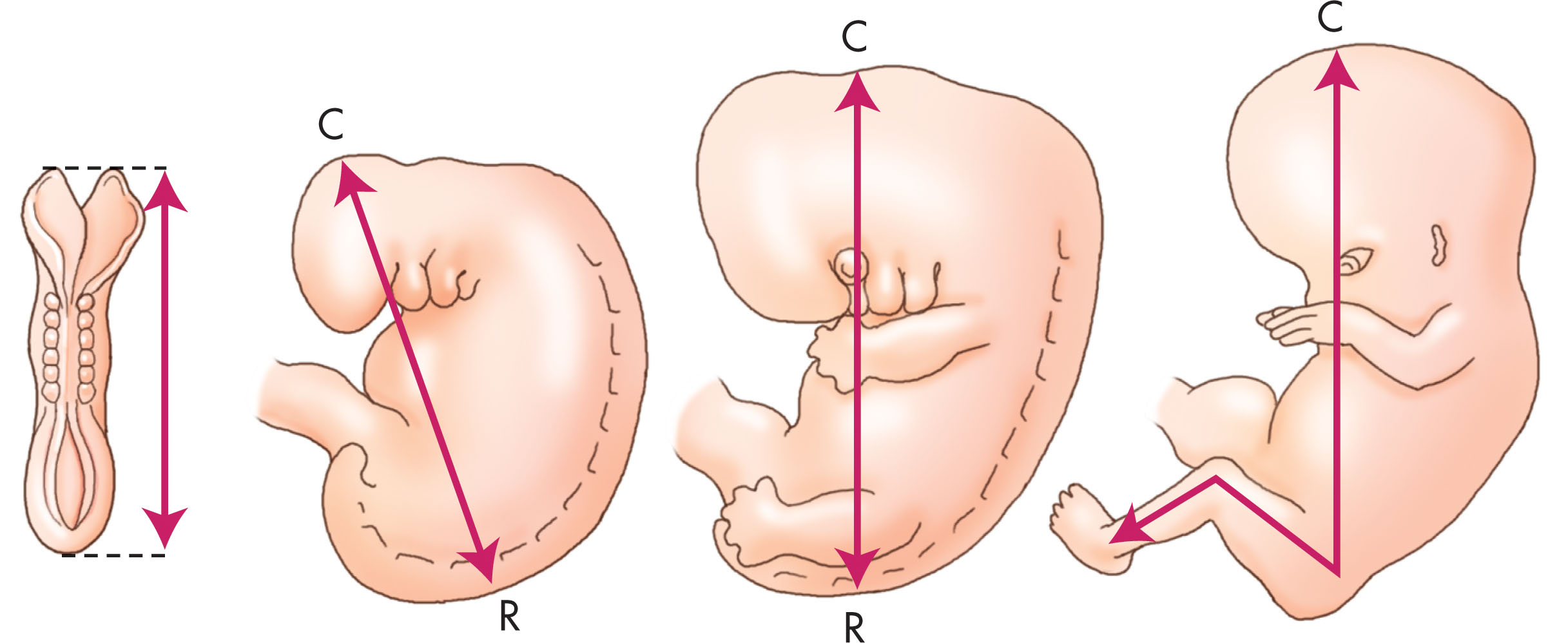
Maternal serum biochemistry values can be very useful in evaluation of the early pregnancy. A direct relationship exists in early pregnancy between the sonographic findings and quantitative serum hCG levels. Gestational sac size and hCG levels increase proportionately until 10 menstrual weeks, at which time the gestational sac is approximately 45-mm mean sac diameter (MSD) , and an embryo should be easily detected by transabdominal or transvaginal sonography.
Quantitative hCG levels in viable IUPs, nonviable IUPs, and ectopic pregnancies have considerable overlap. In general, a normal gestational sac is expected to be visible when the hCG level is greater than 1000 mIU/mL (Second International Standard) to 2000 mIU/mL ( Table 49.2 ). The sonographer must be aware that when the hCG value is greater than the 2000 or even 3000 mIU/mL level, and the gestational sac is not seen by transvaginal ultrasound within the uterus, a normal IUP is not fully excluded; an ectopic pregnancy may be considered. However, a single hCG measurement in a woman with a pregnancy of unknown location does not reliably distinguish a normal IUP from a failed IUP or ectopic pregnancy. If the women is hemodynamically stable, there is little risk in delaying treatment by a few days in a woman with ectopic pregnancy and no adnexal mass on ultrasound. The patient should be reevaluated in 7 to 10 days to confirm if a viable pregnancy is present.
| Menstrual Weeks | hCG Levels (mIU/mL) |
|---|---|
| 3 | 0–5 |
| 4 | 5–426 |
| 5 | 18–7340 |
| 6 | 1080–56,500 |
| 7–8 | 7650–229,000 |
| 10–12 | 25,700–288,000 |
Ectopic pregnancies demonstrate a lower hCG level than IUPs, perhaps owing to limited absorption outside the uterus. The rate of rise or increase in hCG during early pregnancy may help to detect ectopic pregnancies. The normal IUP at less than 7 weeks demonstrates doubling of quantitative maternal serum hCG levels every 3.5 days, or an increase of 66% in hCG levels within 48 hours. If this normal rate of increase is not seen, there is a greater chance that the pregnancy is ectopic. However, some ectopic pregnancies will show a normal rate of increase, and some normal pregnancies will show a reduced rate.
Abnormal pregnancies demonstrate a low hCG level relative to gestational sac development, and it has been shown that hCG levels decrease before spontaneous expulsion of nonviable gestations. Sonographers need to review quantitative hCG levels whenever possible before first-trimester obstetric examinations are performed, because physicians may correlate hCG levels with the gestational sac appearance. This is particularly important when vaginal bleeding or pelvic pain is present or when an ectopic pregnancy is suspected.
At 9 to 10 weeks, hCG levels plateau and subsequently decline while gestation continues. In pregnancies where the fetus is trisomy 21 (Down syndrome), the hCG levels plateau later and decrease much more slowly. Levels of hCG are increased in these pregnancies compared with normal pregnancies, and the difference increases as gestation advances. Consequently, increased hCG levels can be used as a screening marker for Down syndrome during the first and second trimesters. Increased hCG is not a strong marker and does not have sufficient sensitivity to be used by itself in screening for Down syndrome. It is combined with other independent markers to enhance detection. The hCG is a component of first-trimester risk assessment and a component of triple-screen and quad-screen testing performed during the second trimester. The sensitivity of hCG for Down syndrome assessment is improved by measurement of the free beta subunit. Both total hCG and free beta hCG are used for aneuploidy screening in the United States.
Pregnancy-associated plasma protein–A (PAPP-A), also known as pappalysin-1, is an insulin-like growth factor produced by trophoblastic (placental) cells during pregnancy. It is involved in proliferative growth processes such as bone and tissue formation. Maternal serum PAPP-A increases with advancing gestation. In trisomy 21–affected pregnancies, PAPP-A levels are initially lower than in normal pregnancies, but the difference decreases with increasing gestational age. Decreased values of maternal serum PAPP-A may be a marker for Down syndrome during the first trimester but are not useful in the second trimester. Currently, PAPP-A analysis at 9 to 11 weeks of gestational age is the strongest biochemical marker for Down syndrome. However, PAPP-A is not sensitive enough to be used by itself and is combined with hCG levels for serum biochemistry screening or with hCG and sonographic markers for combined screening. Some studies project an association between PAPP-A levels in early pregnancy and pregnancy pathology such as growth restriction, preterm labor, and preeclampsia.
Genomic techniques allow fragments of fetal DNA, cell-free fetal DNA, that originate primarily from the placenta to be found in maternal serum and analyzed from 9 weeks of gestation. The cell-free DNA screening tests have very high detection rates for trisomy 21, but false-positive and false-negative results have been reported. The positive predictive value of the tests varies depending on the prevalence of the condition and risk level of the mother. Before or after cell-free DNA screening, there is substantial value in first-trimester ultrasound screening for structural fetal anomalies.
First-trimester obstetric sonography has evolved rapidly with the high-definition transvaginal transducers, which allow the gravid uterus and adnexa to be visualized with improved resolution by allowing higher frequencies and transducer placement closer to anatomic structures compared with transabdominal scanning. With transvaginal transducers, the pelvic anatomy is imaged in both sagittal and coronal/semicoronal planes. Such coronal imaging of the pelvis is unique within sonography, and the images should not be misconstrued as transverse sections.
Although transvaginal sonography has gained overall acceptance within the medical community because of its improved image quality, transabdominal and transperineal sonography should not be overlooked. The transabdominal approach allows visualization of a larger field of anatomy, which is important when specific anatomic relationships are in question. For instance, the size, extent, and anatomic relationships of a large pelvic mass with surrounding structures can be determined only with transabdominal techniques. In many labs, the transabdominal approach is used first while the patient has a full bladder ( Fig. 49.6 ). This is followed by the detailed transvaginal exam after the bladder is completely emptied. In addition, when necessary, the transperineal approach may be used to visualize the cervix. Three-dimensional sonography may also be performed in the first trimester in those patients who may require better visualization of specific anatomical detail. The use of pulsed Doppler analysis during the first trimester is not recommended and should be performed only when there are clear benefits.
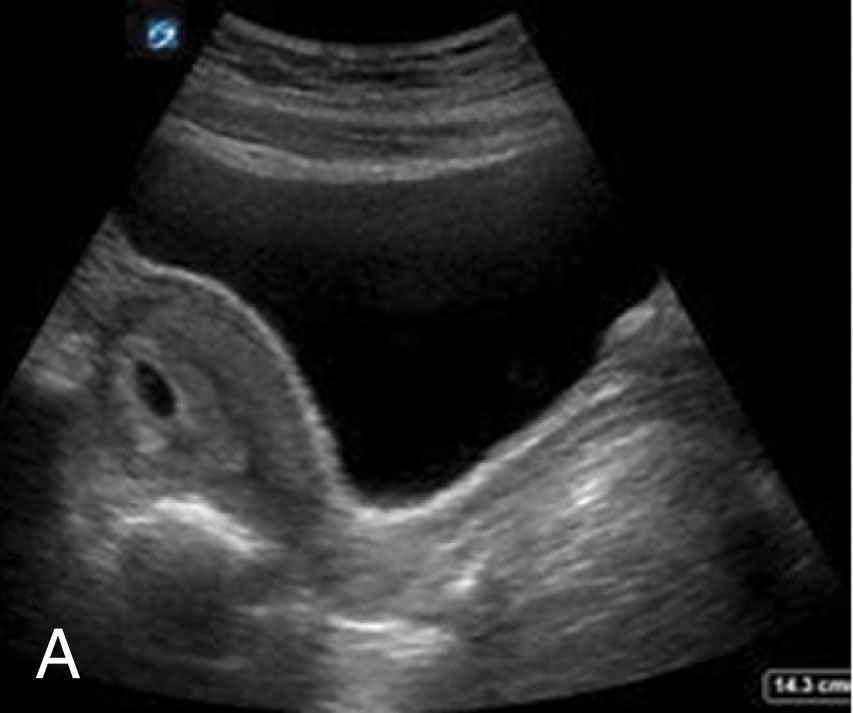
The first 4 weeks of early development are not clearly visible with transvaginal ultrasound. During this period after fertilization, the foundation is begun with the development of the primary yolk sac, the primitive streak, neurulation, intraembryonic coelom, primitive cardiovascular system, and chorionic villi are formulated. Although the pregnancy implants in the decidua on one side of the uterine cavity approximately 1 week after fertilization, it may not be visible on ultrasound for at least another 2 weeks ( Fig. 49.7 ). The variability of determining gestational age by ultrasound is approximately ±0.5 weeks.
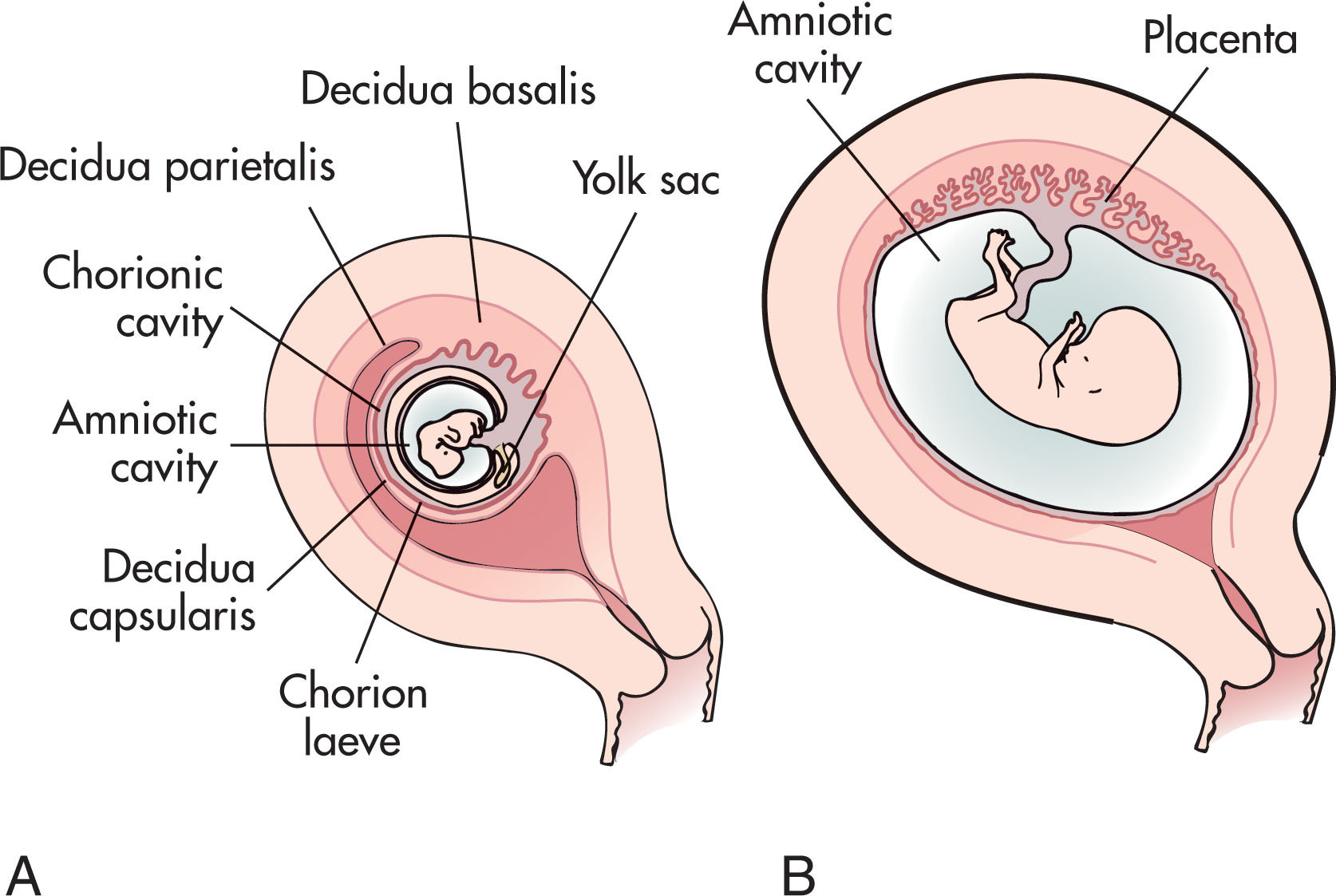
During the fourth week of growth, there is significant development of the embryotic body, with the formation of the primordium of the brain from the previously formed neural tube, the oropharyngeal membrane, and the foregut. Also during the fourth week, hematopoietic cells begin to colonize the newly forming liver. The primordial heart begins to develop and contract. At this point, as the embryo folds in both the cephalocaudal and lateral directions, the intraembryonic coelom is divided by the septum transversum, which becomes the diaphragm. This septum transversum divides the primordial body cavities into the cranial pericardial cavity and the caudal peritoneal cavity. The maxilla and mandible begin to form. The forebrain prominence results in the “C-shaped” curve of the embryo. The limb buds appear at the end of the fourth week.
During the fifth week of embryonic development, the intrauterine pregnancy (IUP) can be visualized well with transvaginal ultrasound. There is marked accelerated growth, with the head growth outpacing the other embryonic structures. The face begins to take form, and the future kidneys are noted by the development of the mesonephric ridges. The embryonic heart develops into a four-chambered structure.
At 5.5 weeks’ gestation, the primitive yolk sac gradually reduces in size to become the secondary yolk sac. The MSD should measure 6 mm. The yolk sac may be used as a landmark to image the embryo/cardiac motion, given the connection between the yolk sac and embryo.
The sixth week shows further differentiation of the limb buds. The primordial ears and eyes develop. Now the fetal liver occupies the majority of the abdominal cavity. The intestines exceed the growth of the abdominal cavity, which causes physiologic herniation of the intestines into the umbilical cord. Spontaneous movements and reflex responses to touch are now present.
An embryo should be seen on transvaginal ultrasound at 6 weeks’ gestational age, when the MSD is greater than 10 mm ( Box 49.1 ). The embryo appears as a 1- to 4-mm echogenic structure within the gestational sac. The fluttering motion inside the embryo represents cardiac activity.
Shape: round or oval.
Position: fundal or middle portion of uterus; a center position relative to endometrium (double decidual sac or intradecidua finding).
Contour: smooth.
Wall (trophoblastic reaction): echogenic.
Internal landmarks: yolk sac typically present when gestational sac is >12 mm; embryo present when gestational sac is >25 mm.
Become a Clinical Tree membership for Full access and enjoy Unlimited articles
If you are a member. Log in here